#quad carbon tech
Explore tagged Tumblr posts
Text
Review - Tour Edge Exotics C723 Driver
“A Tinkerers Dream Come True“ The Address When it comes to golf manufacturers on the rise there’s one brand in particular that has brought the goods year in and year out in recent years. It’s Tour Edge Golf and namely their Exotics lineup of products. When there’s a product release from the Batavia, Illinois-based golf brand, you know that it’s not just about releasing something because it…
#FightAndGrind#SeeUOnTheNextTee#untilthenexttee#diamond face technology#golf#golf club reviews#Golf Equipment Reviews#golf media#Golf News#golfers#quad carbon tech#The Next Tee#tour edge exotics c723 driver reviews#tour edge exotics reviews#tour edge golf reviews#Until The Next Tee#until the next tee golf blog website
0 notes
Text
The Honor Magic 7 Will Launch With AI Assistant In Q4 2024

In Q4 2024, Honor Magic 7 will make its debut with an AI agent personal assistant. Honor unveiled a slew of new devices at IFA Berlin 2024, including the Magic V3, MagicPad 2 tablet, and MagicBook Art 14 laptop. The company separately unveiled its AI-powered solutions for laptops and mobile devices earlier today.
Honor’s AI Agent, a personal assistant for Honor smartphones, is the main topic of discussion here. This on-device AI assistant can intelligently automate activities across several applications and services. It is built to learn from user behaviors and device surroundings. Honor showcased its capabilities by demonstrating how it can use simple voice commands to locate and terminate unwanted app subscriptions. Later this year (Q4 2024), the AI Agent is anticipated to be launched in China along with the Honor Magic 7 Series.
The Magic 7 Pro has the same rounded edges and flat central frame as its predecessors. According to rumors, the forthcoming gadget will also have a high-density silicon-carbon anode battery, an upgraded display with the same 1.5k resolution as the predecessor, and better photography capabilities. Speaking of cameras, it was said that Honor tested the phone using the Sony IMX882 as the periscope telephoto sensor and the 50 MP Omni Vision OV50H as the main sensor.
Honor Magic 7 Features
The Honor Magic 7 has the potential to completely change the way that people perceive cutting-edge smartphone technology. This model, which is the flagship of Honor’s new portfolio, is brimming with cutting-edge features and offers the performance that both casual users and tech fanatics want. The Honor Magic 7 is designed to take on the greatest smartphones available with its innovative display, camera, battery life, and performance. Let’s explore the most talked about features and what makes the Honor Magic 7 unique.
Design and Construction Quality
The Honor Magic 7 has an elegant, high-end design that feels very sturdy in addition to having a refined appearance. Its lightweight but durable construction is a result of the use of materials of aeronautical quality. Its curved edge shape and very thin profile provide for a solid but pleasant grip.
There are several colorful color choices for people to choose from when it comes to phone selections that complement their style. The body’s aluminum-framed glass front and rear give the whole construction an opulent appearance.
Exhibition: An Eye-Candy Treat
A highlight of the Honor Magic 7 is its 6.8-inch AMOLED display. The 3200 x 1440 ultra-high resolution delivers customers crisp photos. 120Hz refresh rate offers fluid animations, touch interactions, and lag-free gaming. This makes it ideal for gaming, productivity, and multimedia.
Additionally compatible with HDR10+, the Honor Magic 7 improves brightness and contrast levels for a more immersive viewing experience. The rich colors and deep blacks will be appreciated by consumers whether they are playing games or watching films.
Hardware and Performance
Qualcomm Snapdragon 8 Gen 2 speeds up all tasks on the Honor Magic 7. Multitasking and switching applications is easy with 12GB RAM and a powerful CPU. The Honor Magic 7 handles demanding games and business applications well.
MicroSD cards may expand the phone’s 256GB.With that much storage, customers never run out of data, apps, videos, or images.
Adreno 730 on the Snapdragon 8 Gen 2 CPU tackles the hardest games. 5G allows low-latency mobile gaming.
Camera: Changing the Face of Mobile Photography
The Honor Magic 7‘s quad-camera system pushes the frontiers of photography. The following are included in the rear camera system:
108MP primary sensor that, even in low light, produces incredibly detailed photos.
12MP ultra-wide lens ideal for group photos and stunning vistas.
3x optical zoom 8MP telephoto lens that’s ideal for far-off scenes.
2MP depth sensor that improves portraiture by adding smooth bokeh effects.
Because to its AI Super Night Mode, the Honor Magic 7 is an excellent night photographer.
Even in dimly lit areas, this function cleverly adjusts the settings to capture more light and detail. Its optical image stabilization (OIS) prevents shaky hands and motions from ruining a perfect shot. The 32MP front selfie camera can take 4K videos and high-quality selfies via the display punch hole. The AI video upgrades, which preserve color accuracy and smooth out footage under varying lighting circumstances, will be a hit with content makers.
Long-lasting Power: Battery Life
With intensive use, the enormous 5,000mAh battery of the Honor Magic 7 is meant to last the whole day. The battery life is fantastic for customers who are often on the move. Whether you use the Honor Magic 7 for gaming, streaming films, or remote work, you can rely on it to meet your needs.
Furthermore, the phone can be fast-charged to 50% capacity in only 20 minutes thanks to its compatibility for 66W Supercharge. By ensuring little downtime, users may continue to be connected and productive.
The Honor Magic 7 also has reverse wireless charging and wireless charging capabilities, so you can charge additional items from your phone, such as smartwatches or earphones, for even more ease.
Program: MagicUI 7 according to Android 14
MagicUI 7 (based on Android 14) makes the Honor Magic 7 easy to use. The latest MagicUI has more customization options, greater security, and AI-driven speed enhancements. MagicUI 7’s multi-window capability, which enables users to run two programs concurrently, side by side, is one of its strengths. The wide display and this functionality make it ideal for productivity aficionados who need to handle many jobs at once.
In addition, the AI performance optimization increases the overall speed of the phone by dynamically allocating resources in the best possible way according to use patterns.
Features of Security
User data is safeguarded by a number of security mechanisms on the Honor Magic 7. Only authorized users will be able to unlock the phone thanks to the in-display fingerprint sensor, and face recognition adds an additional degree of simplicity and security.
With Honor’s TrustZone technology, customers can feel secure knowing that their data is protected thanks to improved encryption and virus protection.
Options for Connectivity
A large number of connection features are supported by the Honor Magic 7, including:
5G connection guarantees very quick upload and download times.
For better wireless internet performance, use Wi-Fi 6.
Bluetooth 5.2 enables low-power data transmission and easy device connection.
NFC for file sharing and contactless transactions.
Support for dual SIM cards is great for those who require distinct numbers for business and personal usage or for regular travelers.
Honor Magic 7 Price
The Honor Magic 7 should be affordable in the high-end flagship class. Initial estimates put the pricing at $899–$1,099, depending on RAM and storage.
Honor Magic 7 Release date
Pre-orders for the phone will begin a few weeks before its Q4 2024 debut. Europe, Asia, and North America are among the important international areas where Honor intends to release the Magic 7. Additionally, prospective customers should anticipate exclusive launch campaigns that provide early adopters with discounts and free accessories.
Read more on Govindhtech.com
#HonorMagic7#MagicV3#laptop#MagicPad2#smartphone#AMOLEDdisplay#QualcommSnapdragon#MicroSDcards#Android14#AIperformance#RAMandstorage#news#technews#technology#technologynews#govindhtech
0 notes
Text
Are Bugatti Cars Worth Their Price?

Bugatti, a name synonymous with automotive excellence, is renowned for its high-performance supercars and their exorbitant price tags. With models like the Chiron and Veyron setting records for speed and engineering, potential buyers often find themselves pondering: Are Bugatti cars truly worth their price? This question involves evaluating various aspects such as performance, technology, craftsmanship, exclusivity, and brand heritage. Let’s delve into why Bugatti cars command their premium pricing and whether they justify the investment.
1. Unmatched Performance
When it comes to performance, Bugatti sets the benchmark for supercars. The Chiron, for instance, boasts a quad-turbocharged 8.0-liter W16 engine that produces 1,479 horsepower, propelling it to a top speed of over 300 mph. The Veyron Super Sport, another iconic model, was once the world’s fastest car. This level of performance is not only extraordinary but also exemplifies the pinnacle of automotive engineering. The cost of such advanced engineering and high-performance components is a significant factor in the overall price.
2. Cutting-Edge Technology
Bugatti vehicles are equipped with state-of-the-art technology that enhances both performance and luxury. From advanced aerodynamics to sophisticated suspension systems and innovative braking technology, Bugatti continuously pushes the envelope in automotive design. Features like adaptive cruise control, advanced traction systems, and digital interfaces ensure that driving a Bugatti is not only exhilarating but also cutting-edge in terms of technology. The inclusion of such high-tech features naturally contributes to the vehicle’s premium price.
3. Exquisite Craftsmanship
The craftsmanship of Bugatti cars is exemplary. Each model is meticulously handcrafted with attention to detail, using the finest materials such as premium leather, carbon fiber, and bespoke finishes. The level of personalization available to Bugatti owners ensures that every vehicle is unique, adding to its exclusivity and luxury. This meticulous craftsmanship and the use of high-quality materials justify the high cost of Bugatti cars.
4. Limited Production and Exclusivity
One of the main reasons for Bugatti’s high price tag is its exclusivity. Bugatti produces only a limited number of vehicles each year, making them rare and highly sought after. The exclusivity of owning a Bugatti is a significant factor for many buyers. This limited production not only enhances the car’s desirability but also contributes to its high market value.
5. Brand Heritage and Prestige
Bugatti’s rich heritage and prestige play a crucial role in its pricing. Founded in 1909, Bugatti has a long history of producing some of the world’s most extraordinary cars. The brand is associated with high performance, luxury, and exclusivity. For many buyers, owning a Bugatti is about more than just driving a high-performance car; it’s about being part of an elite legacy. This association with prestige and historical significance adds considerable value to the price.
6. Investment and Resale Value
While Bugatti cars come with a high initial price, they often retain a significant portion of their value over time. Limited production numbers and high demand can lead to strong resale values, making them a worthwhile investment for collectors. The appreciation of a Bugatti’s value can be a compelling factor for those considering the purchase of a supercar.
7. Exploring Alternatives: Certified Pre-Owned and Used Luxury Cars
For those who appreciate luxury but are seeking more economical options, exploring Certified Pre-Owned Cars and Used Luxury Cars might be a viable alternative. Certified pre-owned vehicles undergo rigorous inspections and come with warranties, offering a high level of assurance and quality at a lower price point. Used luxury cars can provide a similar driving experience and brand prestige without the new car price tag. These options can be particularly attractive for buyers looking to enjoy luxury and performance without the extreme cost of a brand-new Bugatti.
Conclusion
Bugatti cars are undeniably worth their price for those who value extreme performance, advanced technology, exceptional craftsmanship, exclusivity, and brand prestige. The combination of these factors creates a driving experience that is unparalleled in the automotive world. However, for those who may find the price of a new Bugatti prohibitive, exploring certified pre-owned and used luxury cars offers an opportunity to enjoy similar benefits at a more accessible cost. Ultimately, the decision to invest in a Bugatti or an alternative luxury vehicle depends on individual preferences, driving needs, and financial considerations.
0 notes
Text
Current Affairs 2024: Key Highlights for UPSC Aspirants

The year 2024 has been eventful, with significant developments in politics, economics, environment, and technology. For UPSC aspirants, understanding these current affairs is vital as they play a crucial role in the Civil Services Examination. This article, crafted for Khan Global Studies, provides a detailed overview of the major events of 2024 to aid your preparation.
Geopolitical Developments
India’s Role in the Indo-Pacific
In 2024, India continued to bolster its strategic influence in the Indo-Pacific region. The Quad nations (India, the United States, Japan, and Australia) held a landmark summit in Tokyo, focusing on maritime security, counter-terrorism, and climate change. This year's summit resulted in the formation of a new maritime security framework aimed at countering increasing assertiveness in the South China Sea.
US Presidential Election
The 2024 US Presidential Election was a pivotal event with global implications. The election saw a record voter turnout, reflecting deep political engagement. The elected President's policies on international trade, climate change, and defense are expected to influence global geopolitics significantly. India, as a strategic partner, will closely watch how these policies unfold.
BRICS Expansion
The BRICS (Brazil, Russia, India, China, and South Africa) group saw the inclusion of new members, signaling a shift towards a more multipolar world order. The expansion aims to enhance economic cooperation and address global challenges like climate change and economic inequality. This development is crucial for India’s foreign policy and economic strategy.
Economic Developments
Global Economic Recovery
The global economy showed signs of recovery post-pandemic, with growth rates improving in major economies. India's economy grew at a robust pace, driven by strong domestic consumption and government initiatives to boost manufacturing and exports. The launch of the "Make in India 2.0" initiative aimed to attract foreign investment and foster innovation in the tech sector.
Digital Currency Initiatives
Several countries, including India, made significant strides in developing and implementing digital currencies. The Reserve Bank of India (RBI) launched its Central Bank Digital Currency (CBDC) pilot, aiming to enhance financial inclusion and reduce transaction costs. This move is expected to revolutionize the financial sector and provide a competitive edge in the global digital economy.
Environmental and Technological Advancements
Climate Change Mitigation Efforts
Climate change remained a pressing issue in 2024. India hosted the Global Climate Summit, where nations committed to more aggressive carbon reduction targets. India announced its "Net Zero by 2070" plan, focusing on renewable energy expansion, afforestation, and sustainable urban development. These efforts are critical for achieving global climate goals and positioning India as a leader in climate action.
Technological Innovations
Technological advancements continued to shape the global landscape. India made significant progress in artificial intelligence (AI) and quantum computing. The government’s "AI for All" initiative aimed to integrate AI into various sectors, including healthcare, education, and agriculture, to improve efficiency and outcomes. The development of a national quantum mission also underscored India's commitment to becoming a leader in cutting-edge technologies.
Social and Cultural Trends
Education Reforms
Education reforms were a major focus in 2024, with the implementation of the New Education Policy (NEP) 2020 gaining momentum. The policy's emphasis on skill development, digital learning, and inclusivity aims to transform India’s educational landscape. Increased investment in educational infrastructure and teacher training programs is expected to enhance the quality of education and prepare the youth for future challenges.
Public Health Initiatives
Public health remained a priority, with efforts to strengthen healthcare infrastructure and ensure equitable access to medical services. The government launched the "Ayushman Bharat 2.0" scheme, expanding coverage and benefits to more citizens. Emphasis on preventive healthcare and mental health awareness has also been a key aspect of public health policies in 2024.
Conclusion
Staying updated with current affairs for UPSC aspirants. The developments of 2024 highlight significant geopolitical shifts, economic progress, environmental commitments, technological advancements, and social reforms. Understanding these events and their implications will not only help in the examination but also provide a broader perspective on the rapidly changing world.
0 notes
Text
boAt Airdopes 200 Plus in Ear TWS Earbuds, 100 Hours Playback, Quad Mics ENx Technology, 13mm Drivers, Beast Mode(50ms Low Latency), ASAP Charge(5 Min=60 Min), IWP Tech, BT v5.3 & IPX5(Carbon Black)
Price: (as of – Details) Playback- Airdopes 200 Plus TWS Earbuds comes with a massive playback of 100 hours per charge;Clear Voice Calls- Its equipped with Quad Mics ENx Technology which ensures your voice is clear during calls in a noisy environment13mm Drivers- Anticipate astonishing high-fidelity sound at every volume with 13mm Drivers that are built to let you immerse in the music completely…

View On WordPress
0 notes
Text
Incredibly Loud Ferrari 812 N-Largo Attracts Unwanted Attention In South Africa
New Post has been published on https://coolcarsnews.com/incredibly-loud-ferrari-812-n-largo-attracts-unwanted-attention-in-south-africa/
Incredibly Loud Ferrari 812 N-Largo Attracts Unwanted Attention In South Africa
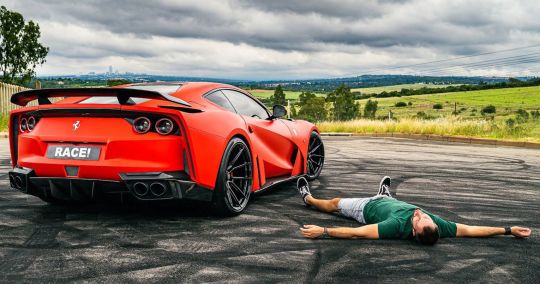
Several elements contribute to the dynamic driving experience. The car's soundtrack is one of these elements plus carmakers and even tuners have been obtaining ways to ensure that a potent automobile can be defined by the most suitable sound. Novitec has done this to its very own version of the Ferrari 812 Superfast —the 812 N-Largo. The Ferrari 812 N-Largo is the most recent featured car associated with Novitec’s "The Supercar Diaries, inch with host Bijon de Kock taking the only example on the Africa continent for a sweet yet noisy drive.
[embed]https://youtube.com/watch?v=TIk2U-jIMtg&feature=oembed[/embed]
Bijon managed to trace this specific 812 N-Largo to Johannesburg, S. africa, in the possession of a certain Marco Casciani (@race1 on Instagram). Interestingly, Marco also owned the other cars showcased in "The Supercar Diaries. inch This modified Ferrari started out as an 812 Superfast, until this and 17 others were transformed by Novitec into the 812 N-Largo.
According to Bijon, this particular 812 N-Largo used to be wrapped within a metallic dark blue color, great it sports a matte red complete. The N-Largo body kit produced this Ferrari wider and look a lot more planted to the road. Its big fender wells are home in order to Novitec's NF 10 NL hi-tech forged wheels, while its carbon-fiber-reinforced polymer aerodynamic dark elements contrast the particular fiery exterior color.
https://www.instagram.com/p/CLB6_DoFZCt
The Novitec Ferrari 812 N-Largo, however , is more than just carbon-fiber-reinforced polymer body and aerodynamic elements. It is also about greater power, better suspension system, and louder sound. The 812 N-Largo has been upgraded to 828 hp (618 kW) of maximum output, which allows it to splash from nil to 62 your in 2 . 8 seconds plus reach a top speed of 152 mph (345 km/h). This strength upgrade is complemented by a modified suspension with front lift program.
ASSOCIATED: Ferrari 812 GTS By Novitec Sports More Aggressive Looks Plus Ups Horsepower To 840
As the movie shows, the 812 N-Largo comes with a Novitec high-performance quad exhaust system, which usually practically amplifies the already noisy sound of the V12 engine. The particular piercing roar of the 812 N-Largo is so deafening that it can be noticed from far away, attracting attention all over the place. Its audiogasmic sound practically announces its presence.

Since the 812 N-Largo is so loud, this even grabbed the attention of individuals along with rifles and stopped Bijon. This seemed they were just curious about the boisterous nature of this bright red-colored Ferrari. Who wouldn't be?
Source: Novitec Group online
FOLLOWING: Listen To This Boisterous Ferrari 599 SA Aperta With Novitec's Sport Muffler Upgrade
#car girls#Cool Cars News#Cool Cars#Trucks and Motorcycles#cool fast cars#Hot Car Girls#Muscle Car Girl#News#The Coolest and Sexiest Muscle Cars In Los Angeles
2 notes
·
View notes
Text
The Tracy Prize - part 1
I’m not quite sure where this one will end up. I’ll just go along for the ride and see what happens.
xoxoxox
Dealing with students was one of the perils of working in a university but today of all days she could have done without a confused first year accosting her after class. With end of year exams approaching more and more of them were needing reassurance that they had grasped a concept correctly. Some days she felt more like a counsellor than a tutor.
A quick glance at the clock showed she had just over an hour before she was due to deliver her presentation. She still had plenty of time to cross campus and dump her books and files in her office but she would have liked longer to go through her notes before pitching her case to the panel. The outcome this afternoon had the potential completely change the course of her career.
Crossing the quad in the bright sunshine of early summer she kept her head down and walked fast. If she could just avoid eye contact with everyone she might make it through without being dragged into another conversation.
She rounded a corner at speed and collided with six foot of solid muscle coming in the opposite direction.
Her world became filled with pain and plaid.
The files smashed into her solar plexus, winding her and causing her to stagger backwards. Books cascaded from her arms to land in an untidy heap on the floor. She would have joined them but for a pair of strong arms with lightening reflexes grabbing her and steadying her backwards tumble.
She looked up into the face of the man who had been both her downfall and her rescuer. She saw concerned brown eyes topped by a tuft of dark hair.
“Are you ok…Dr Ashwell?” A momentary pause as his eyes clocked her staff ID badge.
“I’m fine. Sorry, I didn’t see you” she answered as she crouched down to scoop up her scattered belongings.
The man had barely flinched during their headlong collision although she was sure a block of books to the abdomen couldn’t have been a comfortable experience for him. She expected him to continue his journey and was a little surprised when he crouched down beside her and helped reform the pile.
“A traditionalist, huh?” he queried. “Most people just use the e-book copy now.”
“I like to be able to add my own notes to the margins.” She let out an audible groan as her tablet was unearthed from the pile. The screen was smashed to pieces and one side of the device had popped open exposing the internal workings. “They are also durable. This is just not my day. I can kiss goodbye to that grant” she muttered angrily.
“I was to blame too. Please, let me ping you the funds to replace it.”
“It’s not the tablet that’s the problem. It’s the flies that were on it that I need.”
A slight look of confusion crossed his brow.
“Don’t you have a back-up?”
“Of course I do but only at home. I’m meant to be giving a presentation in…”, she glanced at her watch, “an hour to try and win a research grant. Without my slides and data I may as well not bother.”
“Look, if it helps you can use mine. Maybe download your work and I can stick it on a flash drive for you.”
He drew a sleek tablet out of a smart leather satchel. The bag alone looked like it cost more than the rent on her apartment. The device in his hands was even more sophisticated and clearly had holo-capabilities. Maybe she would take him up on the offer to pay for the damage after all.
“It’s no use. My home set-up isn’t connected to a network. I got burned once by a research partner and keep things off-grid now. It’s a decision I’m currently regretting. Unless by some miracle I can get this thing working I’m screwed.”
She jabbed the power button and the mangled device flickered into life. However, the display was shot to pieces and there no way of calling up the precious information contained within.
“Where there’s life, there’s hope. Pass it here. I take it this is at least has some connectivity so you can use University network?”
She nodded. The tablet was very much a work device for when she needed to be part of the system. She had only transferred her presentation and a few data files on to it for ease that morning. She didn’t share the stranger’s optimism that he could extract her work but shrugged and passed the tablet across anyway.
They moved across to a nearby bench to get out of the path. They and the books were causing quite an obstruction. He pulled a phone out of his pocket and made a call.
“John, I’ve got a challenge for you. I’ll pop you on loudspeaker; I’ve got company. I need you to try and retrieve some files from a tablet that’s seen better days.”
“Must be bad if you’re calling me. So what am I dealing with?”
“It’s got power but it’s completely smashed after I sent it flying.”
There was a snort over the line. “And you guys say I’m the clumsy brother. Turn on your tablet and I’ll run a tech proximity scan.”
The two devices were placed side by side on the bench. The mysterious John was evidently able to operate things remotely as as the screen on the functioning tablet flickered through settings without any input from their end.
“The closest tablet I’m picking up is registered to a Claire Ashwell. Is that the one?”
Claire gave the affirmative. Her eyes widened as a carbon copy of her lock screen, or what her lock screen would have looked like if it wasn’t currently a jumbled mess of cracks and lines, appeared on the neighbouring device.
“But my security settings….”
“Are not a problem” answered the disembodied voice.
The lock screen had disappeared and been replaced with her desktop. She felt a deep seated unease at how easily this stranger at the end of a phone had accessed her computer.
“If someone could pop a flash drive into one of the ports I’ll transfer across what you need. Just tell me what to look for.”
The man beside her complied with the request for a flash drive.
“Uh, just the folder called ‘Tracy Prize’. Everything else I can get from the university system once I’ve replaced my tablet.”
The man beside smiled but she missed it. Her eyes were focussed on the screen which was currently showing that her precious data was being transferred to the flash drive.
“Speaking of replacing your tablet I’ve transferred some funds to your account too. It should cover the cost of the tablet and the software that was on it.”
“How the hell did you do that?!”
“You’ve done internet shopping. Everything leaves a trace.”
The infuriatingly calm voice was doing nothing to dispel her fears of hacking. Her colleagues thought she was an oddball with her bizarre approach to digital security but the man on the other end of the phone had been able to access her tablet and then her bank account in seconds. She was just glad that she hadn’t put any of her more sensitive research on her work tablet.
“Anyway, my work here is done.”
“Cheers John.” replied the man beside her and he disconnected the call. He removed the flash drive and passed it to her. “Perhaps I’ll see you around, Dr Ashwell.”
She found herself on the receiving end of a beaming smile. She sat on the bench for a few moments longer and watched as he disappeared across the square and into a coffee shop.
The whole encounter had only taken a few minutes and if it wasn’t for the mangled tablet and shiny new flash drive in her possession she could hardly have believed it had happened.
She picked up her books and continued the journey to her office. Once safely behind its closed door she pulled out her own phone and called up her banking app. Sure enough her account showed that a healthy deposit had just been made; far more than her basic device was really worth. She resisted the strong urge to delete everything off her phone. Hackers gave her the creeps.
Another glance at her watch. 45 minutes until show time.
She withdrew a sheath of papers from a folder. Print outs of the slides she was about to present. Time to get in the zone.
33 notes
·
View notes
Photo

That Time Forgot: Buick Wildcat
Okay, who would have thought that there was a possibility for you to say “Buick” and “McLaren” in the same sentence? Well, this is quite possibly the only time you can do that. Today, let’s talk a bit about the nameplate’s history... as well as the casting, in today’s installment of That Time Forgot.

Before we talk about the Wildcat in question, let’s go back in time to 1953, when the first Wildcat was introduced.

Enter the 1953 Buick Wildcat, internally known as the Wildcat I. Designed under the direction of GM head of design Harley Earl, the Wildcat was designed for the sole purpose to see if it was feasible to put a fiberglass bodyshell on top of a car. The car was powered by a 322 ci (5.3L) Nailhead V8 producing 188 horsepower. With a wraparound windshield with a 60° slope, the Wildcat successfully influenced the design for Buick’s 1954 cars. After its tour of the auto show circuit complete, the Wildcat was sentenced to the scrapper, but was saved and is now in the hands of Joe Bortz.
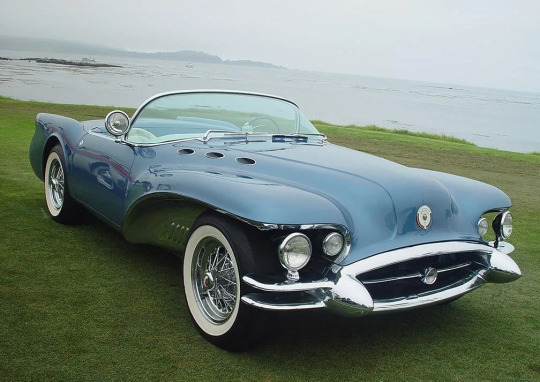
1954 came another Wildcat, internally dubbed the Wildcat II. Also designed under the direction of Earl, this Wildcat was a styling exercise, combining modern elements with classic styling from years gone past; it was because of this that Buick billed the Wildcat as an “American Adventure in Tomorrow's Design”. The car was powered by a 322 ci (5.3L) Buick Nailhead V8, producing 220 horsepower, and was specifically made to be fully functional (like the Wildcat I) in the event that GM chief Harlow Curtice wanted one for his own.
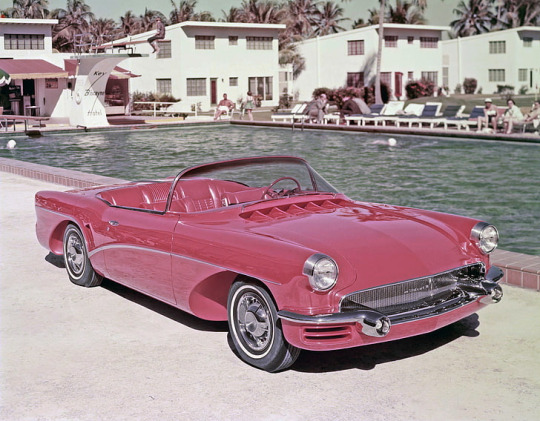
In 1955, another Wildcat came, internally designated... guess what. Also designed by Earl, the Wildcat III was probably the most conservative of the three 1950s Wildcat concepts, although it was quite a bit larger and longer than the previous two Wildcats. Powered by the same 322 ci (5.3L) Buick Nailhead V8 as the previous two Wildcats, the Wildcat III’s V8 was boosted to 280 horsepower with the help of a quad-carburetor setup. Nicknamed the “Toy Convertible”, the Wildcat featured a Twin Turbine Dynaflow 2-speed automatic transmission and featured rear seats, allowing for four passengers. After its tour of the auto show circuit was over, the Wildcat III was ordered to be junked; however, nobody really knows for sure what happened to it.
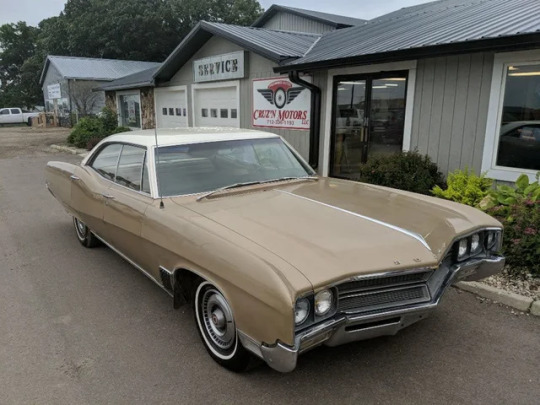
The Wildcat name was subsequently used for a number of full-sized automobiles produced by Buick from 1963 to 1970, but that’s not what you’re here for. Instead, you’re here for this: the 1985 Buick Wildcat.
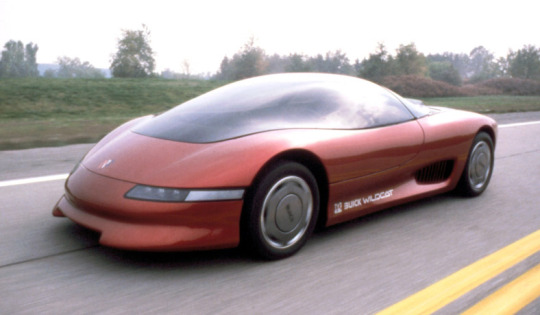
Some fifteen or so years after production of the Wildcat had halted, Buick came out with another Wildcat. This was a futuristic sports car featuring swoopy lines and a canopy which tilted forward for entrance and exit.
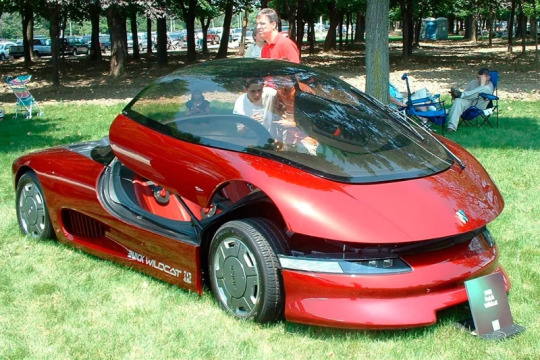
Two prototypes were produced; one non-running one that was showcased at SEMA in 1985, and one fully-functional prototype. The running prototype was powered by an experimental 3.8L Buick V6 built by McLaren Engines (no relation to the British car company).
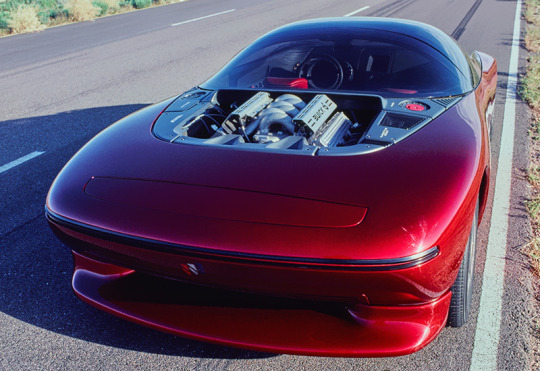
This exposed engine generated some 360 horsepower at 7,000 rpm and 398 lbf⋅ft (540 Nm) of torque. However, given the hardware this thing ran on, performance for the Wildcat... wasn’t that spectacular, with 0-60 mph (0-96 km/h) taking 8.6 seconds. The top speed for the Wildcat was actually electronically restricted to 70 mph (112 km/h); top speed figures for an unrestricted Wildcat remain unknown.

The body was made of fiberglass and carbon fiber, and the car featured a 4-speed transmission which could be manually shifted.
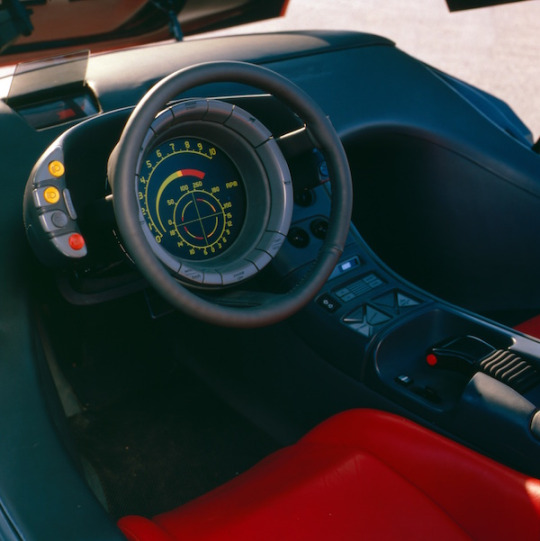
The interior of the Wildcat was highly advanced for its time, with a screen in the middle of the steering wheel display information such as G-force, torque, oil pressure and a compass. To add to that, a heads-up display was also added, displaying speed, mileage and gear selection on the glass canopy.
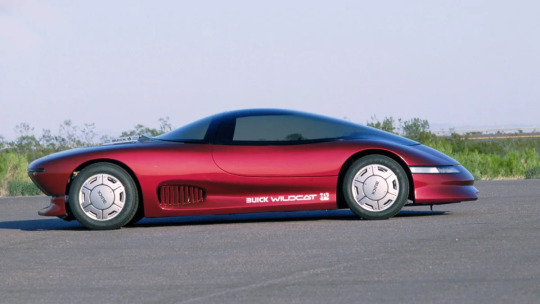
Despite all the high-tech features, all the Wildcats remained prototypes, and they now sit among a sea of other cars at the GM Heritage Center, with the exception of the Wildcat III (which isn’t there).

The Wildcat got its big break in the film industry when it appeared briefly in a scene in the 1993 film Demolition Man alongside some seventeen other GM concepts.
Okay, now that we’ve gotten all of this info out of the way, let’s get to the real reason why you’re here.

This casting was introduced in 1993 in the Demolition Man series, alongside eight other cars that appeared in the movie: these were the Oldsmobile Aurora, Olds 442 W-30, GM Ultralite, GM Lean Machine, Corvette Stingray III, Pontiac Salsa, Pontiac Banshee and the Chevrolet ACC Camaro (’93 Camaro), intended to represent the Chevrolet California IROC Camaro Concept. This casting was designed by Larry Wood. Something notable about the Wildcat was the “canopy” piece, which was simply the car’s body painted black.

This casting has a metal base and plastic body. Early versions will say "'93 WARNER” instead of “'93 MATTEL INC” and “BUICK WILDCAT”; I presume the license with Warner Bros. had expired, so they just scrubbed off the Warner licensing information and put their own on.

The Wildcat enjoyed the privilege of being released quite often when it was in the lineup, but ultimately this casting was doomed in 2005 for one reason, and one reason only: the Final Run Series.

The Final Run Series started in 1999 and acted as what I would consider a very glorified funeral for a casting; Hot Wheels would give these cars special tires and paint, in exchange for vowing to never produce them again by cutting their toolings in half. The Wildcat was unfortunately one of the castings to fall victim to the Final Run Series, and although it might not have been one of the more popular castings to retire that year, it was still retired regardless. As the final batch of cars to be Final Run, having been introduced in the 2005 series, the Wildcat will never be seen again in the Hot Wheels lineup unless a new tool and die is created for it, which I believe is highly unlikely. The Final Run Series itself has been on hiatus since 2006. In total, the Wildcat had eighteen releases.

Of note is that the image above says that Tropicool (Good Humor Truck) is one of the castings that was intended to be Final Run; the actual casting that was Final Run was the Treadator, while Tropicool remains in the lineup to this day.

Always on the receiving end of very loud decals due to the large amount of space on the car, perfect for tampos, the Wildcat will be dearly missed (by me, at least) in the Hot Wheels lineup, and I wouldn’t mind seeing a modern recreation of the Wildcat return to the Hot Wheels lineup as a premium piece.
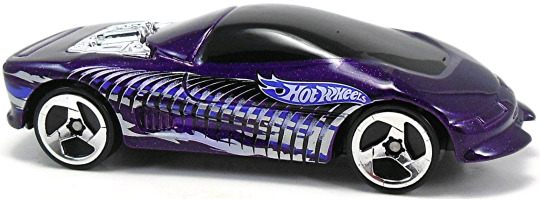
I hope this post has given you a better idea on the history of this futuristic American supercar, and the history of its small Hot Wheels counterpart. As usual, I’d write something like this any day.
1 note
·
View note
Text
Sorry, Apple. These Are The Five Best Laptops for Travelers
Is the world’s best travel laptop dead? Ten years after Steve Jobs introduced the MacBook Air to the world, the laptop is on Apple Inc.’s back burner—and some fear that it’s being phased out entirely.
Rather than redesigning and upgrading the hardware like all of the tech giant’s other marquee products, Apple has left the Air to collect dust, and now the MacBook and MacBook Pro are taking the spotlight. While they’re more powerful, they’re not as convenient for frequent travelers.
On the surface, the MacBook and MacBook Pro measure up to the Air. They’re comparable in terms of size and weight, though they lack the superskinny, sloping gradient design that makes the Air so easy to slide in and out of carry-ons. But the new models lack the Air’s “chiclet” keyboard, with its silent and spacious keys. The replacement “butterfly” design has been so prone to malfunction and sticky keys that Apple recently overhauled its warranty coverage for certain MacBooks. And that’s not even taking into account these models’ smaller screens, shorter battery life, comparatively high price points, and designs that have barely changed in more than a decade.
Add it all up, and it’s no surprise that Mac-loyal warriors around the world are increasingly being seduced by lighter, sleeker, sexier, and more powerful laptops—ones that run Windows and Chrome OS.
These five MacBook replacements are guaranteed to meet your work and play needs, whether you’re bored in a business-class suite, dashing off PowerPoint slides in a hotel room, or banking on the Shinkansen. Based on a global road test that took us from New York to Los Angeles and Tokyo to Paris, these were the best of roughly a dozen new options—all standing out for their excellent portability, keyboard comfort, battery life, and computing power.
If Efficiency Is Your Middle Name …
… get the Google Pixelbook.
Why we like it: The supersexy, two-toned body, which features Gorilla Glass and brushed metal, won’t smudge no matter how many times you have to unpack and repack it around the airport. And at just 2.4 pounds, you won’t feel the Pixelbook in your carry-on. There’s top-of-the-line hardware inside this laptop, including quad-core i7 processors and 16 GB of RAM, making for ultrafast loading speeds and easy multitasking. In just 15 minutes, you can add two hours of juice to the nine-hour battery thanks to the Pixelbook’s quick charger. Dash off emails in laptop mode, use automatic tethering to your Pixel phone to work online sans Wi-Fi, or flip around the screen to watch movies in tablet mode. Besides the free security software, Google gives you 1 TB of complimentary online storage.
Caveat: While Chrome OS has become a nimbler, more versatile operating system in recent years, non-Google-owned productivity tools such as Microsoft Office and Evernote still feel clunky on this browser-based platform. The Crossover app offers a solid workaround.
The Specs:Weight: 2.4 lbsSize: 11.4″ x 8.7″ x 0.4″Price: From $999
If You Want To Turn Heads …
… get the Microsoft Surface laptop.
Why we like it: Call it the first laptop to give the MacBook Air a run for its design money. The Surface laptop comes in a bevy of sharp colors including burgundy, cobalt blue, and graphite gold, and the fabric trim around the keyboard is polished and sophisticated. (It’s also comfortable on the wrists and easy to clean.) The battery lasts an impressive 14 hours, which means you can spend a halfway-productive week in the French countryside without needing an outlet. But be sure to upgrade the hardware specs as you customize your model. For on-the-go professionals, the i7 CPU, 16 GB RAM, and 1 TB solid-state drive are best.
Caveat: The default operating system, Windows 10 S, is cumbersome; it limits you to Microsoft Corp.’s Edge browser and Office programs. Splurge on the Surface laptop commercial edition, which costs $300 more and ships with Windows 10 Pro instead.
The Specs:Weight: 2.76 lbsSize: 12.13″ x 8.79″ x .57″Price: From $799
If You Frequently Work in Cramped Quarters …
…get the Dell XPS 13.
Why we like it: Sometimes, adjectives like “slim” and “lightweight” translate to a far-too-tiny screen. Not so with Dell Inc.’s redesigned XPS 13. It’s five ounces lighter, 0.22 inches thinner, and about 45 percent smaller in volume than the MacBook Air—and yet the 13.3-inch screen is identical in size, thanks to a “virtually borderless” InfinityEdge display that you can order in touchscreen 4K definition. Despite those diminutive proportions, the XPS 13 doesn’t feel flimsy: The body is made of block-machined aluminum. And the small physical footprint means you can easily type away with the screen fully open, whether on an airplane tray table or airport shuttle bus.
Caveat: The built-in webcam is at the bottom of the screen rather than the top, which keeps the bezel thin but makes for bizarre and unflattering angles on conference calls. If you like to keep in touch with the office via video chat, be warned.
The Specs:Weight: 2.76 lbsSize: 12.13″ x 8.79″ x 0.57″Price: From $799
If You Never, Ever Unplug …
… get the Lenovo ThinkPad Carbon X1.
Why we like it: The sixth-generation ThinkPad Carbon X1 from Lenovo Group Ltd. is built for business, with an unparalleled 15-hour battery life. It also has the latest eighth-generation quad-core CPUs for faster performance, multiple inputs (USB-C, standard USB, Mini DisplayPort, and HDMI), fingerprint authentication and a sliding webcam cover, a richly hued HDR screen, and a stealthily quiet keyboard. This is a lean, mean productivity machine—it’s even shock-resistant, temperature-proof, and vibration-resistant, should you get stuck in turbulence. Oh, and did we mention it’s one of the first laptops to have built-in Alexa capability? That means it’ll read you the headlines or give you the local forecast while you’re packing your suitcase.
Caveat: With its signature black exterior and red TrackPoint mouse in the middle of the keyboard, the look is a little outdated.
The Specs:Weight: 2.49 lbsSize: 12.74″ x 8.55″ x 0.63″Price: From $1,367
If You Want the Best Bang For Your Buck …
… get the Huawei Matebook X Pro.
Why we like it: Don’t overlook this Chinese manufacturer. Like its phones, Huawei Technologies Co.’s flagship laptop offers significantly better performance for less of an outlay than its rivals. Even with the latest eighth-generation Intel Core i7 processor and a high-speed solid-state drive, the Matebook X Pro tops out at $1,600—that’s $500 less than its closest competition. There’s plenty to love besides the price, including a superslim bezel, 3K-resolution touchscreen, and four Dolby Atmos-enabled speakers that offer the best audio quality on any laptop we tested. (In small hotel rooms, it’s almost like having surround sound.) Plus, the oversize track pad makes it easy to go mouse-free, while a spill-proof, back-lit keyboard takes the stress out of ordering coffee on your red-eye.
Caveat: Forgive the generic-looking aluminum alloy construction—along with the Gorilla Glass touchscreen, it ensures durability. The improbably placed webcam, like that of the Dell XPS 11, is harder to justify.
The Specs:Weight: 2.92 lbsSize: 12″ x 8.5″ x 0.6″Price: From $1,199
The post Sorry, Apple. These Are The Five Best Laptops for Travelers appeared first on Bloomberg Businessweek Middle East.
from WordPress https://ift.tt/2Ndmvyv via IFTTT
1 note
·
View note
Text
eighth Gen Intel Core i5 versus i7: Which CPU Is Right for You?
You're at your nearby supercenter and you have two workstations before you: one with an Intel Core i7, and one with a Core i5. Contrasting PC CPUs can be convoluted, so which do you pick? Do you go for the one with the alleged expansion in power that their tech master claims it has? Or then again do you save a couple of bucks and get the less expensive one?

Stress not, we're here to address the entirety of your inquiries. Furthermore, to do that, we brought in two apparently indistinguishable Dell XPS 13 PCs (1080p showcase, 8GB RAM, 256GB SSD). The distinction being that one is furnished with an Intel Core i7-8550U, and the other has a Core i5-8250U. How about we perceive how they stack up.
Clock Speed and Price
While the Intel Core i5-8250U and Core i7-8550U are both quad-center processors with the capacity to handle eight strings at the same time, their clock speeds are marginally extraordinary. The Core i5's clock speed is set at 1.6-GHz (3.4-GHz with Max Turbo), while the Core i7's is quicker at 1.8-GHz (3.6-GHz with Max Turbo). The Core i7 likewise has a greater processor reserve at 8MB, contrasted and the Core i5's 6MB. Intel's Smart Cache decides how much space there is in the processor to recall specific capacities and to do them quicker than expected.
center i5-center i7

The numbers appear to be really infinitesimal, however what amount are those numbers going to set you back? All things considered, the two XPS 13s that we tried as of now cost $1,759 (Core i5) and $1,959 (Core i7), making a $200 value hole. The $200 delta proceeded with when I designed the Acer Aspire 5, however while arranging the Lenovo ThinkPad X1 Carbon, I saw just a $150 contrast.
By and large Performance
To test a PC's general exhibition, we utilize a manufactured benchmark called Geek bench 4. The XPS 13's Core i5 CPU scored 13,179, barely beating the 12,941 ultraportable scratch pad normal. Nonetheless, the Core i7 didn't have a huge effect with its score of 13,995, which is a 5.8 percent expansion from the Core i5.
Video Transcoding
On the Handbrake benchmark, which tests how long it requires for a machine to transcode a 6.27GB, 12-moment and-30-second 4K video to 1080p, the XPS 13's Core i5 CPU required 18 minutes and 28 seconds, which slides past the 20:21 classification normal. The Core i7, nonetheless, did it in a short time and 19 seconds, putting a 1:09 (6.2 percent) hole between them.
Dominate Test
To heap on the pressure to the CPUs, we put them facing utilize our Excel test, which expects them to coordinate 65,000 names and addresses. The Core i5 CPU took it out in 1 moment and 12 seconds, 16 seconds quicker than the 1:28 classification normal. The Core i7 did it a lone couple of moments quicker, at 1:09, for a simple 4.2 percent distinction.
3DMark Ice Storm Unlimited
Despite the fact that you're not going to be taking on Watcher 3 with the Intel UHD 620 GPU inside these two XPS 13s, there are a lot of AAA titles that these two can deal with. In any case, which improves?
On the 3DMark Ice Storm Unlimited benchmark, which tests the general illustrations execution, the Core i5's GPU hit 78,801, missing the mark concerning the 78,827 ultraportable note pad normal. In the mean time, the Core i7 nailed a 83,684, successfully making it 5.8 percent better than the Core i5, which is a similar careful increment as the overall exhibition.
Battery Life
With incredible force comes extraordinary force utilization, so we chose to test that by having every PC persistently surf the web over Wi-Fi at 150 nits of splendor. The Core i5 kept going 10 hours and 51 minutes, cruising past the 09:06 ultraportable scratch pad normal. Nonetheless, the Core i7 held fast and made due for 10 hours and 49 minutes, having an unnoticeable 0.3 percent effect to the Core i5.
Which Intel CPU Should You Get?
Albeit the Core i7-8550U beat the Core i5-8250U no nonsense, it truly wasn't by a lot. Probably, the Core i7 is just 6% quicker in by and large execution, which is very disappointing when you think about the value distinction. A solitary moment saved during video altering absolutely isn't valued at $150 to $200.
On the off chance that you work in a field that expects you to run burdening programs the entire day, it could be useful to you. Notwithstanding, the cash would be better spent on updated extra room, a higher-goal show or even a discrete GPU for gaming.
0 notes
Text
2022 Genesis GV70: Gracefully Gorgeous

Genesis is a recently formed car brand that emerged from Hyundai in 2015. Since then, the new marque has developed three sedans and two SUVs. As a builder of premium performance luxury vehicles, Genesis caters to a different crowd of buyers than Hyundai, hence the brand separation. The Genesis logo consists of a shield with “Genesis” written in the center and two wings that extend to either side, representing speed and luxury, similar to the logos of other luxury brands such as Bentley and Aston Martin.
The 2022 Genesis GV70, a compact SUV, is the latest addition to the Genesis lineup. As with other Genesis cars, it boasts their unique design identity called Athletic Elegance.
Athletic Elegance
As the name implies, Athletic Elegance is about achieving a balance between sportiness and refinement in design. According to Jung MyungJin, Senior Researcher of Genesis Exterior Design Team, the core aspects of Athletic Elegance include “sublime proportionality and sophistication of form.”
There are five key design elements to Athletic Elegance:
Crest Grille- inspired by the crest of the Genesis emblem.
Quad headlights and taillights- inspired by the wings of the Genesis emblem.
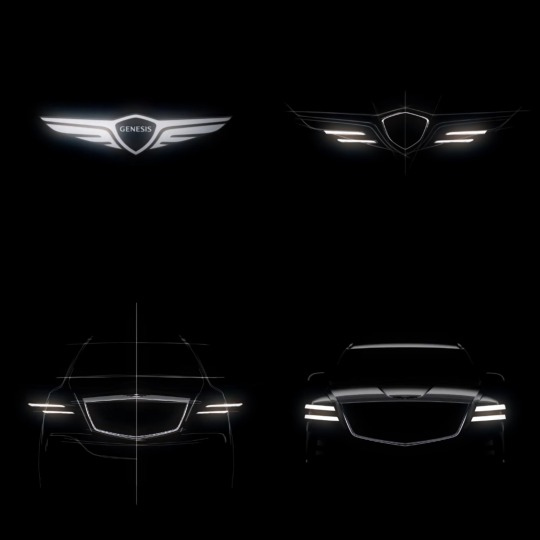
Visualization of the Genesis emblem transforming into the Crest Grille and Quad Lights
Parabolic Line- a single line that stretches across the side-profile and moves elegantly downwards, inspired by classic cars, helping to maintain a simple and pure look.
“Beauty of White Space”- inspired by traditional South Korean architectural design, can be seen in the interior. The interior of a Genesis is meant to evoke feelings of comfort, spaciousness and openness. Kang YeonJi, interior designer of the Genesis GV80 (a larger SUV than the GV70), described a Genesis interior as “cozy, homey, and luxurious... to make passengers feel as if they are resting in a lounge”
G-Matrix pattern- parallel and perpendicular lines that create a geometric pattern. This pattern can be seen all throughout a Genesis car, inside and out.
Exterior
Front
The front of the GV70 features the signature Crest Grille and Quad headlights, inspired by the Genesis emblem, and the G-Matrix pattern, as seen in the grille and lower air inlets. It is very unique to have a car's emblem define the front fascia design, and the GV70 executes it beautifully. It looks tough and sporty, yet luxurious and refined. On the hood we can see two lines in the center that begin at the badge and extend all the way to the top end of the hood, placing emphasis on the wings of the badge, further accentuating the key role of the Genesis emblem in the overall design. Pictured below are two versions of the GV70, with the red being the sport model, differentiated at the front through dark chrome around the grille, blacked-out lower air intake and larger side air vents.
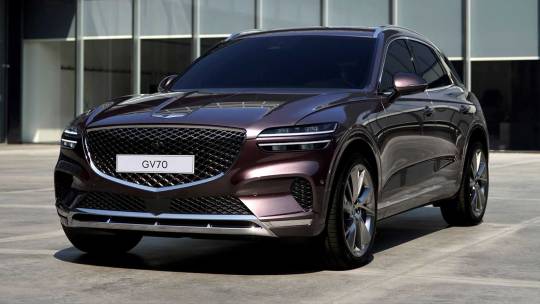
2022 Genesis GV70

GV70 Sport
Side
The side profile features the main Parabolic Line, which stretches across the entirety of the side and has a dramatic slope downwards as it moves from the front to the rear of the car, seamlessly connecting the headlights to the taillights. To occupy the space left behind from the downward slope, a short rear-quarter panel line (called Athletic Power Line by Genesis) sits neatly in between the Parabolic Line and the windows. Personally, I am a fan of this body line setup, as I think it looks pleasantly smooth to the eye and evokes a sense of luxury. Additionally, around the windows is a chrome embellishment that interestingly connects to the rear-quarter window by sloping downward from the top of the other windows. This visually separates the c-pillar from the roof and leads into a rear-quarter window that has smoothly rounded edges. In the sport model, the chrome line at the bottom of the door is blacked-out and the wheels are different, boasting a five-spoke design with the G-Matrix pattern on the spokes.
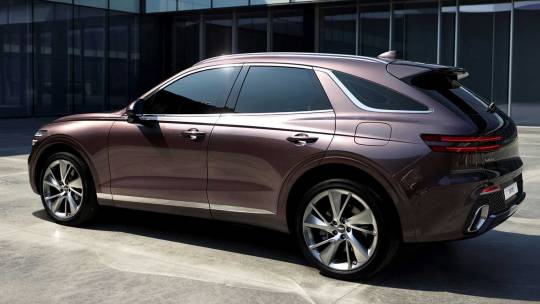
GV70 side profile
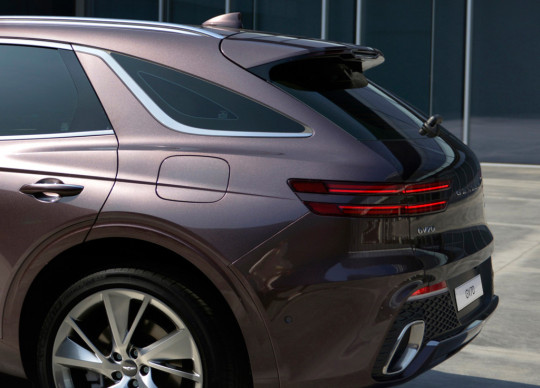
Rear-quarter close-up

GV70 Sport side profile
Rear
The rear also features Quad lights, as part of the Athletic Elegance design philosophy, with Genesis letters situated in between. That is about it for the trunk: lights and badge. It looks simple, clean and easy on the eyes. Moving down to the bumper, we have the license plate mounting area, vertical exhaust pipes, G-Matrix pattern, and a body-colored diffuser that creates a wrap-around effect, encasing the black portion of the bumper. A horizontal body line that sits above the black portion visually separates the lower part of the rear from the upper, further helping to maintain a clean look. The sport model has circular tailpipes and a slightly wider diffuser that extends more to the side.

GV70 rear
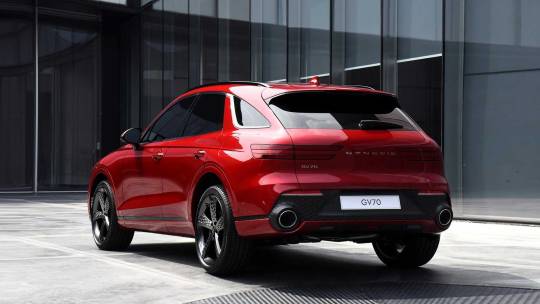
GV70 Sport rear
Interior
The interior looks spacious, comfortable and luxurious. The dashboard is wide and linear, with sleek air vents that are well disguised as a simple horizontal line spanning the width of the dash. The climate control buttons are encased in an oval that expands to the opposing side of the steering wheel, creating a neat area for all the buttons on the dash.
Optional Nappa quilted leather seats come in a variety of colors, such as burgundy, dark green, beige, brown and red, with contrast stitching and even color-matched seat belts. The optional mood lighting in the doors and center armrest is easily the most unique I've ever seen. A series of angular wave lines provide subtle and elegant interior mood lighting that looks more natural and organic than a standard straight line of lighting, as seen frequently in other cars that offer it. In the sport model you have carbon fiber panels in place of the Wave Line mood lighting, as part of the more sporty nature of it.
The two versions have different steering wheel designs. The regular model has an oval-shaped center area to the wheel, with open spaces on the top and bottom, encouraging a relaxed and comfortable grip. The sport model features a three-spoke wheel that is slimmer in the center and encourages a more performance-focused 9 and 3 o'clock grip.
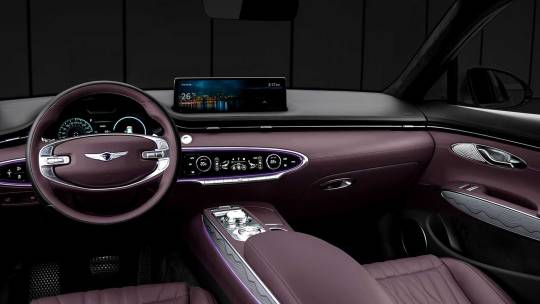
GV70 burgundy interior
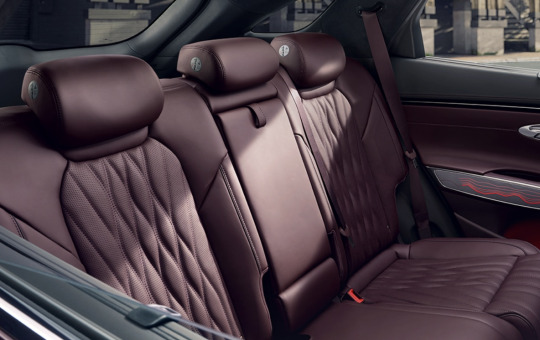
Quilted burgundy Nappa leather seats

Wave Line mood lighting

GV70 Sport interior

Sport model quilted red Nappa leather seats
Technology
The 2022 GV70 has a number of cool, noteworthy tech features. You can register your fingerprint through the infotainment system, and use it to unlock and start the car without a key fob via fingerprint touch-pads. You can even pay for gas and parking through the infotainment system using your fingerprint, through a service called Genesis Car Pay. The digital gauge cluster utilizes cameras to track the driver’s eye movements in order to subtly adjust the information on display for optimal viewing from any angle. The navigational knob used for accessing the infotainment system has a touch-pad that recognizes handwriting, so you can spell out your destination or a name in your contacts, without needing to press virtual buttons on the screen. And finally, an augmented reality navigation feature shows the road ahead through the infotainment screen as you drive, and displays overlaid road and navigational data.
Performance
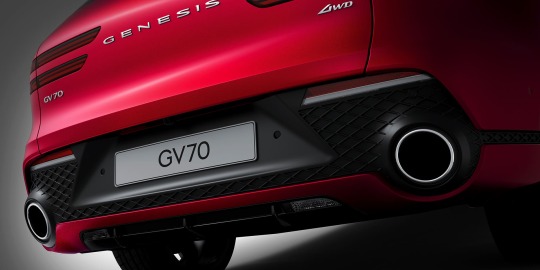
GV70 Sport circular tailpipes and G-Matrix bumper pattern
The sporty looks of the GV70 wouldn’t mean much if they weren’t matched with sporty performance. Three engine options will be available for the GV70: A turbo 2.5 liter inline-four with 300 horsepower and 311 lb-ft of torque, a twin-turbo 3.5 liter V6 with 375 horsepower and 391 lb-ft of torque, and a turbo 2.2 liter inline-four diesel with 207 horsepower and 325 lb-ft of torque. The diesel will be meant more for efficiency, as its power numbers likely won’t provide outstanding performance, but the other two options sound impressive in their power figures. In the handling department, the GV70 will have dynamically adjusting suspension that can alter its damping force based on current road conditions, as recognized by a front camera, to provide a smooth and controlled ride. An electronic limited slip differential can control the power delivery to each drive wheel separately, improving vehicle control in various road and driving conditions. A launch control feature can propel the GV70 from 0 to 60 mph in 5.1 seconds, when equipped with the twin-turbo V6. And, a drive mode selector features Sport and Sport + as options, that adjust power delivery and handling responsiveness characteristics for a more performance-focused experience.
Final Thoughts
The 2022 Genesis GV70 is a stunning machine, inside and out. Its exterior design is sleek and sporty, with unique features such as the Crest Grille, Quad Lamps and Parabolic Line that create a strong Genesis brand identity. The interior is equally pleasing with its high grade materials, minimalist dashboard design and interesting details such as the Wave Line mood lighting.
The GV70 stands out as a luxury SUV, all thanks to the fresh design approaches of Genesis that help differentiate the brand from the crowd.
#Genesis#GV70#GenesisGV70#suv#crossover#luxurycar#performancecar#performancesuv#newcar#upcomingcar#carnews#carblog#autoblog#carblogging#amazingcars247#bestcars#carlove#carenthusiast#carpassion#lovecars#koreancar
0 notes
Photo

Dell XPS 17 9700 Laptop, Price, Specification, Drivers
Dell XPS 17 Laptop has an outstanding powerful performance with Eternal Inspiration with color-accurate display and 3D sound. After all, it has 43.18 cm that is slim and thin. As well as, it has powerful graphics and processor with a unique and advanced design that you can fly away.
The processor is the 10th generation, Intel Core i7-10750H.
Video Card is NVIDIA GeForce GTX 1650 Ti 4GB GDDR6.
Hard Drive is 1TB M.2 PCIe NVMe Solid-State Drive.
Memory is 16GB DDR4, 2933 MHz, 2x8G.
The display is 43.1 cm.
Operating System is Windows 10 Pro - 64bit.
Price of Dell XPS 17
17.0 FHD+ non-touch is $ 2,861.70 / € 2,458.18 / £ 2,203.87/ Rs 2,14,105.78
17.0 UHD+ touch is $ 3,150.24 / € 2,707.11 / £ 2,428.25/ Rs 2,35,685.77
Buy Amazon.com
Drivers of Dell XPS 17 9700
After all, you can download the driver of Dell XPS 17 9700

XPS 17 9700 Drivers download
Also, Click here for Dell XPS 13 and XPS 15
Configuration of Dell XPS 17 9700
Processor
After all, You can configure the processor as the 10th Generation, Intel Core i7-10750H [12MB cache, 5.0 GHz, 6 cores].
OS
Operating System is Windows 10 Pro 64bit - English
Video Card
NVIDIA GeForce GTX 1650 Ti 4GB GDDR6
Display
17.0 inches FHD+ [1920 x 1200] InfinityEdge, Of course, Non-Touch Anti-Glare 500-Nit Display.
17.0 inches UHD+ [3840 x 2400] InfinityEdge, As well as, Touch Anti-Reflective 500-Nit Display.
Memory
16GB DDR4, 2933 MHz, 2x8G.
Hard Drive
1TB M.2 PCIe NVMe Solid State Drive.
Color
Fiber Composite Palmrest
Platinum Silver with Black Carbon
CNC Machined Aluminum in
Microsoft
There is no Microsoft Office License but 30 days of the trial offer.
Security
After all, The Security Software is McAfee Live Safe for 12 months.
Warranty of Dell XPS 17 9700
Of course, there is a Warranty of One year premium support plus and onsite services.
Damage Protection
After all, There is none accidental damage protection.
Keyboard
After all, The keyboard is Black Backlit, which is US/International with Fingerprint Reader
Ports
4 Thunderbolt 3 with the display port and the power delivery
1 Headset which is a Combo jack of microphone/headphone
Slots
1 wedge-shaped lock slot
1 SD-card slot
Weight & Dimension of Dell XPS 17
Weight is 2.11 kg to 2.51 kg [4.65 lb to 5.53 lb]
Height is 0.77 inch
Width is 14.74 inch
Depth is 9.76 inch
Camera
Of course, It has a 720p at 30 fps HD RGB IR camera with a Dual array microphones
Speakers and Audio
After all, it has a Stereo woofer 2.5 W x 2 and stereo tweetwe 1.5 W x 2 = 8 W total peak
Chasis
Of course, it has a Exterior Chassis Materials with Aluminium
Wireless
After all, It has a Killer Wi-Fi 6 AX1650 [2x2] and Bluetooth 5.1
Primary Battery
As well as, it has a 6 cell battery with 97 WHr Integrated.
Regulatory
As well as, The Regulatory is Energy star 8.0
Features of Dell XPS 17
Operating system
Of course, You will get the Windows 10 Pro or Windows 10 Home that features the best combination and improvements that you will definitely like it.
Slots and Ports
Full-size SD card reader v6.0
2x Thunderbolt 3 with a display port and power delivery
3.5 mm microphone/headphone that is combo jack
Also, a Wedge-shaped lock slot
2x Thunderbolt 3 with a display port and power delivery

Dell XPS 17 9700
Weight and Dimension
weight is 2.11 kg to 2.51 kg
Height is 19.5 mm
Width is 374.45 mm
Depth is 248.05 mm
Sound
As well as, It has an immersive 3D soundscape with Waves Nx 3D Audio and quad-speaker design. After all, It has top-mounted mics that allow talking from 14 ft away.
Power of Dell XPS 17
Of course, It is equipped with creative tools that are better and faster.
It has a 100% Adobe RGB display, so that can let you edit photos with confidence.
Of course, NVIDIA’s graphics are rendering of high-resolution graphics and videos accelerates with performance.
It has an Intel 10th Generation, i7&i9 processor that is enough for the workload.
After all, It has massive flash storage.
Of course, It has 10th Generation Intel Core processors that bring you desktop-caliber creativity to the laptop. Of course, it is enough to edit, capture, and share your creations so faster.
It has GeForce GTX 1650 Ti graphics that is enough to accelerate the creative apps.
32GB of memory is enough for workloads also. Of course, it is damn faster that users will love it.
Masterful

XPS 17
Light and Cool: Of course, The aerospace industry made black carbon fiber palm rest to minimize weight and maximum strength.
It also has stainless steel logos which is a laser cut-out.
The screen is Superior: It has a Corning Gorilla Glass 6, that is so strong as well as scratch resistance and impact.
Diamond cuts: After all, It is scratch resistant surface, superior, and prevent damage if you unplugging and plugging.
Password: Also You can log in two different ways. first is an Infrared camera that can recognize your face and unlock. And second is the fingerprint reader power button so that can let you log in.
Easier open: After all, The twin coil press-fit hinge is design to maximize its screen and enable 4 side Infinity Edge. Of course, that is easier to open and it is stable.
Eco wise
Of course, It is Energy Star certified.
Recycle: As well as, It's 90% of the parts can be recycled.
Material: Of course, It is free of materials like mercury, lead, cadmium, phthalates. Also, EPEAT registered and PVC/BFR free.
Sea: After all, 25% of materials consist of ocean plastics collected and 75% is made from recycled plastics.
Accessories of Dell XPS 17

Dell XPS 17 9700
1_Dell Pro Backpack 17 - PO1720P
2_Dell Premier Sleeve 17 - PE1721V
3_Dell Premier Wireless Mouse and Keyboard - KM717
4_Dell Notebook Power Bank Plus, USB-C 65WH - PW7018LC
Of course, You can contact us to let us know if we are missing something on our page. After all, We cannot guarantee, if anything is wrong on this page. I hope you like it and Thank you for your visit.
#Stepphase #technologies #technology #tech #technews #techworld #techtrends #smartphone #apple #techupdates #futuretechnology #newtech #techgeek #technologynews #technologythesedays #smarttechnology #technologylover #technologytrends #technologyblog #gadgets #smartphone #gadget #marketing #digital #india #technologyisawesome #amazing #repost
0 notes
Text
John Lewis helps shoppers sleep easy with new Eco mattress – to meet demands
There’s no denying we’re now more aware than ever of the impact our lifestyle choices are having on the environment. So, John Lewis & Partners have listened to customer’s concerns and created the Eco mattress.
Related: Best mattress 2020 – top choices for a perfect night’s sleep, including sprung and memory foam
Searches for ‘Recycling’ on its site are up 122 per cent compared to last year the retailer reveals. Evidence customers are becoming more environmentally conscious when shopping for their homes.
New Eco Mattress at John Lewis & Partners
The mattress has been designed with sustainability at the forefront. Alongside maximum comfort and support, to provide customers with the perfect night’s sleep.
The innovative recyclable EcoMattress is filled with layers of EcoFlex fibres. The soft polyester filling in the mattress also uses 100 per cent recycled fibres.
In terms of eco credentials a king size version re-uses over 200 recycled plastic bottles that could ended up in a landfill. Those are some pretty impressive stats. Better still the materials used are all vegan-friendly.
Buy now: EcoMatress Double, £599, John Lewis & Partners
Eco credentials
The mattress features a groundbreaking glue-free high density Cortec Quad pocket spring system. A total of 750 pocket springs in the king size provide targeted, pressure-relieving and balanced support for a comfortable nights sleep.
High-tech materials and processes make this new mattress the retailers most modern to date.
‘We are a business led by purpose. With customers becoming more thoughtful about the environment we want to make it easier for them to shop sustainably,’ explains Emily Wimbourne, bed buyer at John Lewis & Partners. ‘Over the past year we have seen online searches for ‘Sustainable’ increase by 42 per cent and ‘Eco’ by 26 per cent.’
Related: How to clean a mattress – for a sweeter night’s sleep
The Eco mattress is made in a carbon-neutral factory in Britain. It’s completely glue and chemical-free. Meaning it’s 100 per cent recyclable and therefore diverted from landfill.
It’s estimated a staggering 7.5 million mattresses are sent to landfill each year in the UK.
If you are looking to get rid of an old mattress, The John Lewis mattress recycling service diverts mattresses from landfill. Last year it received and responsibly disposed of over 65,000 mattresses.
The post John Lewis helps shoppers sleep easy with new Eco mattress – to meet demands appeared first on Ideal Home.
from Ideal Home https://ift.tt/3gLUIni
0 notes
Photo

NOVO- Zeblaze THOR 5 PRO 3GB+32GB WIFI GPS 7.1 Android Sat Cena 21900 din Large Storage | Dual Camera | Big Battery Tech Specs Chipset: MTK6739 1.25GHz, Quad Core Memory: RAM: 3GB, ROM: 32GB GPS: GPS / GLONASS / Beidou Sensors: Heart-rate Sensor, Proximity Sensor, Accelerometer Camera: 5.0MP +5.0MP Dual Camera Battery: 800mAH Network Frequency GSM: 850(B5)/900(B8)/1800(B3)/1900(B2) WCDMA: 850(B5)/900(B8)/1900(B2)/2100(B1) 4G FDD: 2100(B1)/1900(B2)/1800(B3)/850(B5)/2600(B7)/900(B8)/B12/800(B20) TDS-CDMA: B34/B49 TDD: B38/B39/B40/B41 Google Play: Supports WIFI: Supports Speaker: Supports OTA Upgrade: Supports SIM Card Slot: Single SIM(Nano SIM) Operating System: Android 7.1.1 Dimensions: 54*50*16.8mm Product weight: 65.7g 12 Reasons to Choose THOR 5 PRO 1.6''LTPS Crystal Display | 1.25Ghz, Quad Core | 3GB RAM+32GB ROM | 5.0MP+5.0MP Dual Camera | CORNING Gorilla Glass 3 | Ceramic Bezel | 800mAh Powerful Battery | Exchangeable Leather Straps | 4G LTE Global Bands | GPS/GLONASS | High Precision Sensors | Change Your Watch Face Design - Real Watch Aesthetics Premium Design Experience the marriage of cutting-edge technology and traditional watch-making, designed to match different styles. - Ceramic Bezel The ceramic bezel is crafted using 23 separate processes. This material, usually used on many luxurious watches, is 6 times harder than stainless steel, highly resistant to abrasion, and lightweight. - Hybrid Leather Straps Elegant genuine Italian leather on the outward side, skin-friendly silicone layer on the inward side. stainless steel physical buttons for easy navigation and an exchangeable 22mm durable silicone watch strap, Comfortable, breathable and sweat resistant. Glass Fiber Reinforced Polycarbonate 3D laser carbon fiber texture is used around the case for better sense of reality. Display - More Screem, More Immersive THOR 5 PRO is featured with 1.6'' IPS crystal display, the screen to body is up to 85%. supporting purer and wider field of vision than before with fully immersive experience. Big Screen - 1.6''LTPS Crystal Display CORNING - Gorilla Glass 3 320*320 - High-resolution Display (у месту Kragujevac) https://www.instagram.com/p/CCoYkS5J1Xa/?igshid=ol57cmlc8l8o
0 notes
Text
The Coolest Cars I’ve Ever Driven
Some cars are born cool; some cars achieve coolness; and some have coolness thrust upon them. It’s a nebulous thing, shape-shifting with the zeitgeist, yet anchored by perspective and context. Thus, AMC Gremlins, Honda Preludes, and Subaru Brats are quietly bubbling up the coolness index, fueled, no doubt, by a heavy dose of post-modernist irony for Radwood and Malaise-era cars. Who knows, Pontiac Azteks could be next.
Over the past 35 years, I’ve driven many of the usual suspects on most automotive cool lists: Ferrari Daytona, Citroën DS, various 993-series Porsche 911s, Jaguar E-Type, the original Pagani Zonda, one of the first Mustangs ever built, to name but a few. So what follows is a list of not-so-usual suspects, cars that, all these years later, I also remember as special. To me, they’re cool.
Bugatti EB110 GT
I hear the faint metallic clatter of quad cams and 60 tiny valves. The clutch is firm, but the take-up is progressive, and the jewel-like 3.5-liter quad-turbo V-12 behind my shoulders pulls cleanly and smoothly from as little as 1,000 rpm as I ease the French blue Bugatti EB110 GT out onto the runway.
Deep breath and … nail it! There’s a bit of lag initially, but once the four small IHI turbochargers spool up, the acceleration is phenomenal, the V-12’s basso low-speed growl becoming a hard-edged scream as the revs build, punctuated by the metallic fisssst-pshaw of the four wastegates blowing off the excess boost as I work my way up the six-speed manual gearbox. The sprint to 60 mph is done and dusted in less than four seconds. I’m told the EB110 GT has a top speed of 212 mph. Given the frenetic surge of acceleration showed no sign of abating when I had to get out of the gas at about 150mph, I’m not about to argue.
I’m driving what is—at the time —the third fastest production car ever built. That’s a cool moment, right there.
But the Bugatti EB110 GT was much more than that. For years, the modern VW-owned Bugatti enterprise quietly ignored any potential modern ideations, preferring to highlight cars from the pre-war Ettore Bugatti era. But the EB110, conceived and created in the late 1980s under the direction of Italian businessman Romano Artioli, is now officially recognized as a ‘middle period’ Bugatti.
Okay, the EB110’s design was a little workmanlike —the bizarre weirdness of Marcello Gandini’s concept ended up being toned down by architect Giampaolo Benedini, the man who designed the spectacularly chic Bugatti factory in Campogalliano, Italy, for Artioli. But the car drove surprisingly well, even at real-world road speeds.
Yes, you needed to keep the little V-12 spinning to keep the turbos on boost—the torque peak of 451 lb-ft arrived at a middling 3,750 rpm—but the 27/73 front-to-rear torque split reduced the understeer that blights many all-wheel-drive cars and helped make the transitions to power oversteer more manageable.
And, more importantly, in terms of its technology —a unique 3.5-liter V-12 with four turbochargers and five valves per cylinder, carbon fiber tub, all-wheel drive—the EB110 truly was a benchmark car.
It still is. The Bugatti EB110 helped define the format of the modern hypercar. It is the missing link between the 197mph Porsche 959 of 1986—the turbocharged, all-wheel-drive, high-tech rocketship that was, at the time of its launch, the fastest production car in the world—and the 1479-hp Bugatti Chiron, which has hit 304 mph in Super Sport 300+ spec.
Oh, and it’s rarer than either the 959 or the Chiron. Just 128 were built.
Lancia Delta HF 4WD
The sun is shining, but up here on the ridge, high above the choking smog of Italy’s Po Valley, the snow lies thick on the ground, crowding the edges of the narrow, twisting road. The little red car is alive in my hands, probing, teasing, willing me to go further and faster, to find the edge of the envelope.
The twin-cam 2.0-liter turbo four under the hood is smooth and punchy, with an induction roar at full throttle that makes it sound like a baby Ferrari. The gear ratios are superbly spaced, the steering delicate and precise, the brakes strong and easily modulated.
The poise! The grip! The traction! In early 1987, I’d never driven anything so breathtakingly brilliant as this little red car. It looked scarcely different to thousands of other small hatchbacks jostling along the roads in and around Turin. But the Lancia Delta HF 4WD was indeed a special car, offering performance and road-holding equaled only by exotica costing two or three times as much.
Unveiled at the Turin Motor Show in April 1986, the Delta HF 4WD was to morph, not long after I drove it, into the more powerful Delta Integrale. It wasn’t the first all-wheel-drive hot hatch. Mazda’s BF-series Familia/323 Turbo GT 4WD, which launched in October 1985 and was a car I’d already driven in Australia, beat it to the punch. But it was far more influential, especially after the World Rally Championship switched from the fast-but-dangerous Group B rally racers to the road car-based Group A formula. The Delta HF became Lancia’s front-line rally weapon.
From Subaru’s WRX STi and Mitsubishi’s Lancer Evos I through X, to the forthcoming Toyota GR Yaris, generations of compact, all-wheel-drive, rally-inspired performance road cars have taken their lead from the Delta HF 4WD.
The 2.0-liter engine under the Delta HF 4WD’s hood was shared with other Lancia models, but it was upgraded with a water-cooled Garret T3 turbocharger and intercooler, as well as a Weber Marelli engine management system. It made 164 hp at 5,250 rpm and 188 lb-ft of torque at 2,500 rpm that would go to 209 lb-ft at 2,750 rpm with overboost. They’re not huge numbers by today’s standards, but the little Lancia only weighed about 2,600 pounds.
The HF 4WD’s secret sauce, however, was an all-wheel system that comprised a Ferguson viscous-coupled center differential that nominally distributed 56 percent of the torque to the front axle and 44 percent to the rear axle, which had a Torsen torque-sensing diff.
Outside the Mazda and a handful of Audis, all-wheel-drive performance cars were a rarity back then. I confess the Lancia took a little getting used to. Treating it like a front-drive hot hatch— rushing the corner entry, turning in early and playing with throttle get the car to rotate —would result in the front end resolutely ploughing wide, propelled by the prodigious traction at the rear.
The Delta HF 4WD, I learned on that blistering run through the Italian hills, rewarded a more thoughtful approach and, above all, precision. But driven cleanly, this little hot hatch—half the price of an Audi quattro Coupe (and, truth be told, half as well built, with half as good ergonomics)—could humble a Ferrari on a mountain road.
And that’s what made it cool.
Ford Falcon Phase III GTHO
I think the guys at Australia’s Wheels magazine still get requests for the photo. Black and white, it shows a pair of hands grasping a skinny three-spoke steering wheel and a hood punctuated by a ribbed Shaker scoop. The road ahead, out of focus, disappears dead straight into the distance. But these are the details you notice last. Your eye is always drawn to the dials at the center of the image. On one the needle is nudging 6,700 rpm; on the other, it’s past 140 mph.
It’s probably the most famous photograph to ever appear in an Australian car magazine. Snapped by then Wheels shutterman Uwe Kuessner, it was taken from the back seat of a Ford Falcon Phase III GTHO driven by Mel Nichols (who later went on to become editor of Britain’s Car magazine) early one morning in 1971 on the main highway between Sydney and Melbourne.
I remember, as a car-crazed kid, staring at that photo for what seemed like hours, utterly entranced. Kuessner had captured a magical moment in a magical car and shared it with us all. I felt I knew what it was like to take Australia’s greatest musclecar to the limit.
Eighteen years later, I’m editor of Australia’s Street Machine magazine. The hands grasping that skinny three-spoke steering wheel are mine and view over the hood is in vivid technicolor, all brilliant orange-red Vermillion Fire and black stripes. The Shaker shivers and shimmies as the Cleveland 351 V-8 under the hood idles gruffly. The clutch is heavy, and the Top Loader four-speed needs a good shove to get first gear. I dance a little two-step with the gas and clutch—it’s a barely detuned race engine, after all—and the Falcon growls away.
The ride is softer than expected, and I feel the squidginess in the sidewalls of the 70-series tires—yes, 70-series, which in 1971 were considered low-profile—but after a few miles, I learn to brake early and straight, let the Falcon take a set on corner entry, working through the compliance, and then balance it using the throttle.
The road opens up. and I give the 351 its head. There’s a deep, guttural roar, and the nose lifts as the Falcon squats on its rear axle and surges forward. The speedo needle swings past 100 mph, and then I’m on the brakes, a hefty shove needed to get the 1970s-era disc/drum setup to slow the old Ford down in time for the oncoming corner. Around town, the GTHO feels heavy and tiresome. But out here on the open road it comes alive, eager and responsive and hungry for miles.
The Falcon Phase III GTHO was a homologation special built by Ford Australia for the then-500-mile production touring car race on the formidable Mt Panorama circuit at Bathurst—the ancestor of today’s blue-ribbon Australian V8 Supercars event. The 1971 Falcon was the fourth facelift of the third generation of Ford’s compact sedan, launched in the US in 1966, and put into production in Australian in 1967. To create the Phase III GTHO, Ford Australia engineers pilfered parts from Mustangs and Torinos—the engine and transmission, the Shaker, even the rear deck spoiler and the steering wheel—and added a few go-faster tweaks of their own.
The Falcon Phase III GTHO was a hero car of mine, and not just because of Uwe Kuessner’s photo and Mel Nichols’ story. This 140 mph four-door was one of the coolest sedans in the world in 1971, rivaling the legendary Mercedes-Benz 300SEL 6.3 for sheer pace. I’d watched it race and win at Bathurst.
They say you should never meet your heroes. They’re wrong.
Bentley Continental R
The cop stepped off the sidewalk and turned towards us, all silver-buttoned uniform and silly hat. He saw the big blue Bentley coupe steaming majestically towards him through the mid-morning traffic in London’s posh West End and leapt back smartly to wave us through. In the rear-view mirror I saw him step back out on the road again and bring the traffic behind us to a halt.
It may have been a trick of the light, but I swear he tugged his forelock as we swept past.
Two-door Bentleys seem everywhere these days, but back in the 1990s, the Bentley Continental R was a commanding presence and not just because this 17.5-foot-long, 6.7-foot-wide two-door was bigger than almost anything else on the road at the time. It was the first Bentley since the 1950s not to share sheet metal with a Rolls-Royce. It was powered by turbocharged version of the Rolls-Royce 6.75-liter V-8 that developed a relatively modest 330 hp but 444 lb-ft of torque at little more than idle.
And it was still largely hand-built: The 1994 model I was driving was one of fewer than 680 Continental Rs completed since the car’s launch in 1992. These days, Bentley makes that many Contis every month.
On a quiet road outside London, I squeeze the gas and the big V-8 rumbles quietly, like gunfire from a distant battleship, as the big coupe rocks on its haunches and then lunges down the road. It takes about 6 seconds for the speedo needle to swing past 60 mph, the tach needle tickling a mere 1,450 rpm. Given enough room the Continental R would go on to hit 152 mph, punching a massive hole in the air that left lesser cars rocking in its wake.
The steering is a bit like daytime television—light and vague–but contrary to my expectations, the big Bentley doesn’t handle like an aircraft carrier in a hurricane. Once I’d calibrated the delay between steering input and chassis output, and understood the electronically controlled shocks could cope with the gargantuan weight transfer induced with the merest whiff of the throttle, the Continental R proves remarkably composed through corners.
I quickly learn that fingertips and a feather foot is all the imperious Bentley needs to crush a winding road, that rumbling locomotive of an engine barely raising a sweat as I ride high, wide, and handsome in a cabin redolent with the rich tang of hand-stitched leather and suffused with the warm glow of hand-finished walnut. It felt like the fastest gentleman’s club on earth, at once gloriously indulgent, yet quietly conservative.
And it’s this curiously English dichotomy, carefully contrived in today’s Bentleys and suffused with the cold rationality of modern electronics, that made the Continental R so cool.
Back in London, I pull up alongside a Rolls-Royce. The chalk-stripe suited banker riding in the back can’t help a double take when he realizes the occupants of the Bentley don’t quite fit the typical Continental R buyer profile.
“It’s all right mate,” observes my companion, photographer Dougie Firth, a phlegmatic Yorkshireman, “He’s just trying to figure out whether we’re rock stars or royalty.”
“Why?”
“He might have to be nice to us. Rock stars make a lot of money, you know.”
1963 Indy 500 Winner Ol’ Calhoun
Indianapolis Motor Speedway, 2011. I can’t believe I’m actually doing this. I’m sitting—shoehorned, in truth—behind the wheel of the actual race car Parnelli Jones drove to victory in the 1963 Indianapolis 500. It’s a car I have utterly adored since I was a kid. And I’m about to drive it. At the Brickyard.
Built in LA in 1960 by the legendary A.J. Watson, it’s the quintessential archetype of the Offenhauser-powered front-engine roadsters that dominated at Indy for more than two decades. Nicknamed Ol’ Calhoun, it’s been run only a handful of times since 1964. Spare parts are almost impossible to find, and the rarest items on the car are the 48-year-old Firestone tires. I’d looked them over before climbing into the cockpit: The rock-hard rubber is crazed with a million cracks, and the sidewalls are fraying in a few places.
I’ll be taking it easy.
The late Bill Spoerle, who at the time was heading the team looking after the Indianapolis Motor Speedway Museum’s collection, stands alongside the cockpit and glares at me balefully. Spoerle started at the Speedway in 1961, the year Jones took his rookie test in this very car. In other words, Spoerle has been around long enough to know that letting a journalist loose in one of his priceless cars is a bad idea.
Spoerle, speaking with a German accent so thick you’d swear he’d arrived on the boat from Bremerhaven the day before, warns me once again to keep feathering the throttle once the engine fires. Let an old Offy idle, he’d reminded me several times, and you’ll snap teeth off the cam gears.
A giant 40 hp electric motor that was designed to crank Pratt & Whitney radial aircraft engines into life is connected to Ol’ Calhoun. There’s a turbine-like whirr, then a click as the gears in the starter are locked, and I squeeze the throttle as Bill leans in and flicks on the magneto. Contact! The Offy fires, coughs, fires, and coughs again. Bill’s waving his hand up and down slightly. Pump the gas. The engine spits, sputters and then roars into life, a calico-rip of sound from the exhaust pipe at my left shoulder.
Now comes the part I’ve been dreading: Getting cleanly out of pit lane. I’m six inches taller than Parnelli Jones, and my knees are splayed awkwardly either side of a big four-spoke steering wheel that appears to have been stolen from a Greyhound bus. The transmission is on the left of the cockpit—the entire engine is mounted to the left of the center-line of the chassis—and I have to contort my ankle around it to find the tiny clutch pedal that skims the right hand side of the tiny, two-speed Ford Model A transmission.
As I’m pushed away from standstill, I struggle to get the clutch to the floor, and muscle the shift lever forward to engage low gear. There’s a brief and ugly gnashing sound, but the lever hits home and I gently feed in the revs as I gingerly feel for the clutch to bite.
There! I squeeze the gas some more. A slight twitch from the rear end as the old Firestones struggle for grip. We’re rolling! I feed in more gas and almost immediately begin wrestling for high gear. There’s more metal on metal contact, another twitch of the tail, and Ol’ Calhoun rolls out onto the Speedway.
My hands are tingling. The engine is bolted directly to the frame, and while it might only be a four-banger, those bangs are truly titanic. The twin-cam, 16-valve Meyer-Drake Offenhauser, designed in the 1930s, displaces almost 4.2-liters and runs a compression ratio of 14.5:1 on methanol fuel. Back in 1963, an Offy fresh from the factory would be good for 400 bhp and 340 lb-ft, but an engine builder for a top team could boost that to 449 hp and 410 lb-ft.
All that torque makes Ol’ Calhoun easy to drive at low speeds. In deference to the engine’s age and the fragility of the tires, I’m limited to 3,500 rpm, about 80 mph with the low rear axle gears the IMS mechanics have installed. But even at cruising speeds, driving this old roadster around this storied track is one of the most overwhelmingly visceral experiences I’ve ever had in a car.
I can still hear the constant tickety-tick-tick-tick from the Offy’s valvetrain and the exhaust snarling in my left ear, see the rear tire humming right there, over my right shoulder, and feel the steering wheel buzzing in my hands and the grit peppering my face. It was beyond cool.
As I return to the pits, I recall that Parnelli Jones averaged 150 mph around here to put Ol’ Calhoun on pole back in 1963, drifting a race car with dirt-track axles and a 1930s engine through the turns at more than 130 mph and hitting 180 mph down the long chutes. Yeah, those old-time roadster drivers had cojones like coconuts.
The post The Coolest Cars I’ve Ever Driven appeared first on MotorTrend.
https://www.motortrend.com/news/coolest-cars-driven-by-angus-mackenzie-photos/ visto antes em https://www.motortrend.com
0 notes
Text
2021 BMW M4 CS Coupe Specs, Price, Release Date
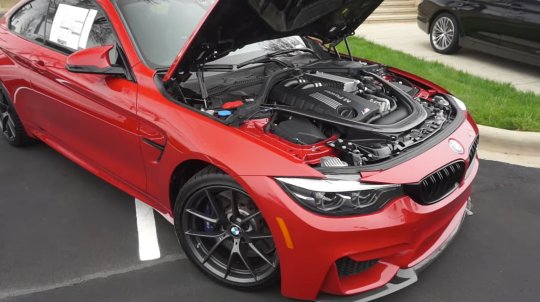
2021 BMW M4 CS Coupe Specs, Price, Release Date - Today we're gonna talk about this 2021 BMW M4 CS coupe. So Before we jump into all the specifications for the M4 CS, this vehicle is a more hardcore version comparing it to the standard BMW M4. and if we go ahead and take a first look at it, this entire hood is actually finished off in carbon fiber. Entirely constructed of carbon fiber and it literally weighs nothing one finger, you can easily open and close it. There is literally no way to it. This car has a lot of carbon fiber all around, and a lot of different performance features comparing it to the standard car. This Article Is Just A Rumor
2021 BMW M4 CS Coupe Changes
Exterior Design The overall length is 184 and a half inches with a wheelbase at 110 points 7. the width is seventy-three points six inches with a height of 54 points eight and the ground clearance is four point seven inches. the 2021 BMW M4 CS Coupe has ventilated and drilled rotors in all four corners measuring fifteen inches upfront with a four-piston brake caliper. The rear rotors come in at fourteen point six inches with a two-piston caliper. And this particular spec has a staggered set of wheels measuring 19 inches upfront and 20s in the rears. They're finished off in a satin gray with a split 5 spoke design, and they also featured the M logo on them all wrapped in a Michelin performance tire. The M4 has a lot of aggression upfront with many lines and angles. It also has a lot of openings for maximum cooling to the engine. This particular spec features a gloss-black kidney-shaped grille with vertical slots in the center. With have the M4 logo over on the right side, this spec also features a carbon fiber lower front splitter. There are also four parking sensors upfront, a lot of openings in the lower side of the front bumper with fins on each side. Coming up top, this has BMWs LED headlights with LED daytime running lights. And those flow nicely around the front bumper to give it an aggressive look. Then the hood has some nice contours in it with a functional heat extraction vent right in the center. Also then a raised portion in the center of the hood to indicate where the engine is mounted.

2021 BMW M4 CS Coupe Exterior And then moving to the side of the M4, there's a functional air vent behind the front wheels that allow airflow to escape the front wheel wells. And then you'll notice a prominent body line going around that cutting its way all the way to the rear taillights of the car. This has body-color door handles as well as body-color side mirror caps with the integrated LED turn signals in them. And the more gloss black trim finds its way all around the windows. And the overall side profile of the M4 has a very proportional and sporty look, I love all the sharp lines. The bulging fender arches in the front and the rear and in contrast against the red and the gray wheels have a really cool look. This M4 also features the carbon fiber roof that actually lowers the center of gravity of the vehicle by a few inches, has a really good look against the car, adding to the theme of performance and lightweight. And then making our way to the rear, this has oh le detail lights that have a nice look, a lot of cool contours in them. We have a carbon fiber lip spoiler to match the front splitter, the M4 CS badge, and then the backup camera is located in the center. We have four parking sensors in the rear and more carbon fiber on the lower diffuser, even with some fins in it. And then you get your chrome quad-tip dual exhaust system with the M logo laser etched into the top of it. And the whole rear end heists the design together to give the M4 a great look. So there's a good look at the overall exterior as well as some of the performance specifications on the BMW M4 CS. Interior Design This car has a lot of black leather and Alcantara all throughout it. And taking a look at the door panel, this features black leather along the top of its very soft feeling has a premium look. We also have black stitching on it, and then we have a strap right here to close the door with the BMW colors. We have your aluminum release hammer right here, and then your window controls as well as mirror and the power sunshade. You'll notice some lightweight designs for this door panel. We have an Alcantara armrest right here with a little bit of padding on it. And then this is a completely composite door panel, very cool to see on a car like this just for lighter weight and a more performance feeling. And we have the aluminum door sill with 2021 BMW M4 CS Coupe, this does feature power seats. All the controls are on the side, as well as the memory seat functions. And then on the seats, we have black leather along the sides with black Alcantara within the centers. And then you get the really cool design here. This actually cuts into the back of the seats, which is very nice to see. And then we have a perforated design in the center with a really nice look. You can see all the stitching and contours within the seat. Taking a look at the gauge cluster, we have the tach over on the right side as well as your temperature. Your speedometer on the left with your gas. And one thing very cool with the heads-up display if you hit the m1 button, it'll come upon the heads-up display with a performance looking tach. Going across the entire screen with your speedometer on that as well. And then going back into the normal mode that giant tech goes away.
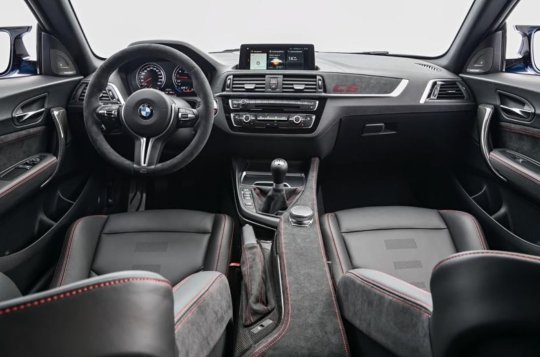
2021 BMW M4 CS Coupe Interior On the left side of the steering wheel, we have cruise control settings as well as two different M mode preset buttons. We have all the voice commands and Bluetooth and audio control over on the right. This does have steering-wheel-mounted paddle shifters, they have a really nice feeling to them, and they're quite large. And then the stock on the left side tapping the BC button that'll go through different trip information within the gauges. You can see your speedometer, the date and time, and then different trip information, as well as temperatures, and then your wipers are on the right side. Sitting back here, you actually have a ton of space, I do have the driver's seat set to my height 5 foot 11. and I have a few inches of knee room, which is very impressive, and my feet fit very nice and comfortably. That composite paneling continues in the rear, very nice to see that. You have the same Alcantara for the armrests. And for being a little bit of a stripped out version is the 2021 BMW M4 CS Coupe. This is a lighter way more design for the track. You still get a lot of really nice creature comforts black leather on the top here. And a huge window right here to make it actually pretty open sitting back here. The Headroom, my head is barely touching the ceilings and not too bad for a car like this.
2021 BMW M4 CS Coupe Engine
Underneath the hood, this features a three-liter inline 6-cylinder twin-turbocharged engine. The cs pumps out 454 horsepower and 442 pound-feet of torque. The engine is paired to a 7-speed dual-clutch automatic transmission and sends the power to the rear wheels. And with a curb weight coming in around 3,600 pounds. you're looking at a 0-60 time at 3.7 seconds with a quarter-mile at 12 seconds flat at 121 miles an hour. Top speed at 174 miles an hour. And running off a 15 point 8-gallon fuel tank, you can expect to get 17 miles per gallon in the city and 23 out on the highway.

2021 BMW M4 CS Coupe Engine
2021 BMW M4 CS Coupe Price and Release Date
And the model that we're looking at today is finished off in Melbourne red metallic and has an MSRP at a hundred and six thousand dollars. Read the full article
#2019BMWM4CSCoupe#2020BMWM4CS0-60#2020BMWM4CSChanges#2020BMWM4CSColors#2020BMWM4CSCoupeRwd#2020BMWM4CSEngine#2020BMWM4CSExterior#2020BMWM4CSForSale#2020BMWM4CSInterior#2020BMWM4CSPrice#2020BMWM4CSRedesign#2020BMWM4CSReleaseDate#2020BMWM4CSSpecs#BMWM4CSCoupe
0 notes